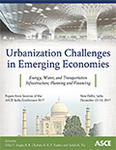ASCE India Conference 2017
Aerobic Biological Treatment of Pesticide Industry Effluent: A Kinetic Evaluation
Publication: Urbanization Challenges in Emerging Economies: Energy and Water Infrastructure; Transportation Infrastructure; and Planning and Financing
ABSTRACT
The study was conducted 1. to examine the performance of aerobic bacteria in treating a pesticide industry effluent and to quantify the biodegradation in terms of bio-kinetic parameters at steady state and 2. to study the inhibition caused by the pesticide effluent on un-acclimated ethanol enriched aerobic culture. The performance of the treatment was monitored based on total organic carbon (TOC), total nitrogen (TN), and sulfate removal at different SRTs. Highest COD removal of 80% was observed for SRTs greater than 8-day. The steady state kinetic parameters k, Ks, Y, and kd were 2.52 d−1, 49.68 mg COD/L, 0.25 mg VSS/mg COD, and 0.46 d−1, respectively. The pesticide industry effluent caused a competitive inhibition above a dose of 1.6% on un-acclimated culture. High treatment efficiency can be achieved in aerobic biological treatment when the biomass gets acclimatized to the pesticide industrial effluent.
Get full access to this article
View all available purchase options and get full access to this chapter.
ACKNOWLEDGEMENT
This research was funded by Ministry of Human Resource and Development, Government of India, under FAST program.
REFERNCES
Agarwal, A., Prajapati, R., Singh, O. P., Raza, S. K., and Thakur, L. K. (2015). “Pesticide residue in water? a challenging task in India.” Environmental Monitoring and Assessment, 187(2), 54.
Alavanja, M. C. R., Hoppin, J. A., and Kamel, F. (2004). “Health Effects of Chronic Pesticide Exposure: Cancer and Neurotoxicity.” Annual Review of Public Health, 25(1), 155-197.
Baghapour, M., Nasseri, S., and Derakhshan, Z. (2013). “Atrazine removal from aqueous solutions using submerged biological aerated filter.” Journal of Environmental Health Science and Engineering, 11(1), 6.
Bandala, E., Andres-Octaviano, J., Pastrana, P., and Torres, L. (2006). “Removal of Aldrin, Dieldrin, Heptachlor, and Heptachlor Epoxide Using Activated Carbon and/or Pseudomonas fluorescens Free Cell Cultures.” Journal of Environmental Science and Health, Part B: Pesticides, Food Contaminants, and Agricultural Wastes, 41(5), 553-569.
Bhardwaj, T., and Sharma, J. P. (2013). “Impact of Pesticides Application in Agricultural Industry: An Indian Scenario.” International Journal of Agriculture and Food Science Technology, 4(8), 2249-3050.
Bhattacharyya, D. (2009). “Degradation of dyes and color removal in advanced bioreactor systems.” Ph.D. thesis, Univ. of New Brunswick, Fredericton, N.B., Canada.
Bhattacharyya, D., and Singh, K. S. (2011). “Colour removal and the effect of reactive dyes on acid producing anaerobic microorganisms.” Water Quality Research Journal of Canada, 46(3), 211-218.
Chen, S., Sun, D., and Chung, J. (2007). “Treatment of pesticide wastewater by moving-bed biofilm reactor combined with Fenton-coagulation pretreatment.” 144, 577-584.
Grady, C. P. L. (1990). “Biodegradation of Toxic Organics: Status and Potential.” Journal of Environmental Engineering, 116(5), 805-828.
Gupta, P. K. (2004). “Pesticide exposure - Indian scene.” Toxicology, 198(1-3), 83-90.
Han, K., and Levenspiel, O. (1988). “Extended monod kinetics for substrate, product, and cell inhibition.” Biotechnology and Bioengineering, 32(4), 430-447.
Kim, I. S., Young, J. C., and Tabak, H. H. (1994). “Kinetics of acetogenesis and methanogenesis in anaerobic reactions under toxic conditions.” Water Environment Research, 66(2), 119-132.
Kopytko, M., Correa-Torres, S. N., and Plata, A. (2016). “Sequential reductive and oxidative conditions used to biodegradation of organochlorine pesticides by native bacteria.” IOP Conference Series: Materials Science and Engineering, 138, 12018.
Lari, S. Z., Khan, N. A., Gandhi, K. N., Meshram, T. S., and Thacker, N. P. (2014). “Comparison of pesticide residues in surface water and ground water of agriculture intensive areas.” Journal of Environmental Health Science and Engineering, 12(1), 11.
Lin, C. Y. (1990). “Aerobic treatment of pesticide-plant wastewater.” Biological Wastes, 34(4), 301-311.
Mulchandani, A., and Luong, J. H. T. (1989). “Microbial inhibition kinetics revisited.” Enzyme and Microbial Technology, 11(2), 66-73.
Radosevich, M., Traina, S. J., and Hao, Y. (1995). “Degradation and Mineralization of Atrazine by a Soil Bacterial Isolate †.” 61(1), 297-302.
Shaalan, H. F., Ghaly, M. Y., and Farah, J. Y. (2007). “Techno economic evaluation for the treatment of pesticide industry effluents using membrane schemes.” Desalination, 204(1-3), 265-276.
Smith, L. H., Carty, P. L. M. C., and Kitanidis, P. K. (1998). “Spreadsheet Method for Evaluation of Biochemical Reaction Rate Coefficients and Their Uncertainties by Weighted Nonlinear Least-Squares Analysis of the Integrated Monod Equation Downloaded from http://aem.asm.org/on March 31. 2015 by INDIAN INST OF TECH.” 64(6), 2044-2050.
Subramanian, A., Ohtake, M., Kunisue, T., and Tanabe, S. (2007). “High levels of organochlorines in mothers’ milk from Chennai (Madras) city, India.” Chemosphere, 68(5), 928-939.
Vivekanandhan, N., and Duraisamy, A. (2012). “Ecological Impact of Pesticides Principally Organochlorine Insecticide Endosulfan: A Review.” Universal Journal of Environmental Research and Technology, 2(5), 369-376.
Yedla, S., and Dikshit, A. K. (2001). “Removal of endosulfan using aerobic mixed bacterial culture.” International Journal of Environment and Pollution, 15(5), 543.
Young, J. C., and Cowan, R. M. (2004). Respirometry for environmental science and engineering. SJ Enterprises Springdale, AR.
Information & Authors
Information
Published In
Urbanization Challenges in Emerging Economies: Energy and Water Infrastructure; Transportation Infrastructure; and Planning and Financing
Pages: 1 - 10
Editors: Udai P. Singh, B. R. Chahar, Indian Institute of Technology, H. R. P. Yadav, Institution of Engineers (India), and Satish K. Vij
ISBN (Online): 978-0-7844-8202-5
Copyright
© 2018 American Society of Civil Engineers.
History
Published online: Dec 13, 2018
Published in print: Dec 13, 2018
Authors
Metrics & Citations
Metrics
Citations
Download citation
If you have the appropriate software installed, you can download article citation data to the citation manager of your choice. Simply select your manager software from the list below and click Download.
